Get branding tips and expert advice delivered straight to your inbox.
This blog provides a comprehensive overview of the most effective brand strategy development techniques. Use our detailed instructions to demystify the art of building a successful brand strategy, and get expert advice to set your strategy apart.
In this blog, you’ll learn how to develop a comprehensive brand strategy document with step-by-step instructions and pro tips. Plus, you’ll find a free brand strategy document starter kit with fully customizable templates and examples.
What Is a Brand Strategy Document?
A brand strategy document communicates the essential factors that make your brand unique. Employees and agencies that work with your brand can use the document as a reference to keep the brand consistent across all channels.
A brand strategy extends your business strategy, with a specific focus on meeting business goals through building and maintaining a consistent brand. Anyone hired to promote your brand (i.e., marketing departments, sales teams, PR, external agencies) can easily refer to this document to uphold and maintain brand integrity.
The final brand strategy document looks different for every company, but all include should include the brand’s core elements, its visual identity, tactics, guidelines for brand communication, and metrics. Large companies typically have a brand strategy document in place and revise it annually. Small businesses owners more commonly need to create a document as their business grows and the brand owners expand beyond one or two people.
Anat Baron, a brand building expert and keynote speaker, says that the brand strategy document “is the bible for your brand. It defines the strategy that lays the groundwork for all of the tactics that every employee and hired agency can then execute. Everyone who touches your brand must know its essence. This document holds the most important factors that make your brand special.”
Why Is a Brand Strategy Document Important?
A brand strategy document ensures that you create a consistent, cohesive brand message. Your business uses the strategy reflected in the document to communicate your brand’s reputation, including what makes your brand unique.
As your team grows, it’s helpful to have a brand strategy document to avoid miscommunication that could potentially weaken your brand perception. As Baron notes, “Things are moving so quickly, and there are so many more people who are working on your brand these days. If you don’t have the key attributes laid out, it could lead to mistakes and confusion about who you actually are.”
Your brand strategy document helps to align your brand strategy with employees and agencies. Larger marketing departments, agencies, and PR teams create consistent content specific to each channel as they work to deepen brand equity, or the value of your brand over time as perceived by your target audience. Since many of today’s large teams are distributed, they often refer to a brand strategy document to help align tactics and accomplish your brand’s overall strategic goals.
You can also use your strategy document to meet business goals. A clearly executed brand strategy attracts customers who share your values. You can begin to build trust with your prime customer by targeting them in ways that resonate with their interest — this includes developing a brand promise so that customers know what to expect when they purchase your product. Having a loyal customer base means higher conversion rates, increased brand loyalty, and greater awareness. The work you put into creating a solid brand strategy document is sure to have a high return on investment.
Who Helps to Create a Brand Strategy Document?
Marketing teams most commonly work to create the brand strategy document, but communication departments and external agencies sometimes own the document. Regardless of who the owner is, the team should develop the document with input from relevant stakeholders, including company founders and senior leadership. The designated team will craft, revise, and bring to life the brand strategy throughout your organization. This team can be as small or large as it needs to be to cover all roles.
Creating and maintaining a strong brand strategy document involves four categories of work. One person may be responsible for filling multiple of the following duties:
- Align the Business and Brand Goals: This role helps to bridge the gap between the brand and the business by communicating with the executive team to make sure the brand stays on track. Often, the person responsible for overseeing marketing takes on these responsibilities.
- Preserve the Brand Identity: Typically, this function falls on the creative lead, who might also be the same person who aligns the brand and business goals. Responsibilities of this role include overseeing and enforcing the brand guidelines.
- Coordinate Marketing with Brand Strategy: This owner creates the marketing strategy and the strategic content. They also coordinate the team on the day-to-day tasks and allocate their use of resources.
- Maintain Brand Knowledge: Once the strategy is complete, the communication lead is in charge of documenting the information, building and maintaining the brand library, and organizing brand assets. This person helps to educate anyone new to the brand, such as new hires, and may also facilitate organization-wide training when brand guidelines change.
Brand values are at the very core of the foundation the creates an organization’s culture. Someone on your designated team may need to take on the role of educating the company on creating a culture that reflects its brand values represented in your brand strategy document. Strong company culture exists when everyone, especially executive leaders, lives out the brand values.
Lindsay Pedersen is a brand strategist and the owner of Ironclad Brand Strategy. She encourages leadership to adopt behaviors modeling the brand: “Brand strategy is a business strategy and will only be carried out insofar as all employees see the CEO model the brand, not just when it’s easy, but especially when it’s hard.”
Steps to Create a Brand Strategy
Creating your brand strategy starts as an extension of your business strategy. First, define your target audience, value proposition, and competition. Then, focus your strategy around satisfying customer needs. Make a content marketing plan to communicate and track your metrics.
It takes time to master how to create a brand strategy, but it doesn’t have to be an intimidating process. Use our step-by-step framework below to create your roadmap and build a lasting brand people love.
The following detailed instructions will help you get started from the ground up. If you are rebranding an existing brand, conduct a brand audit to assess and pivot your strategy. Use our roundup of brand strategy templates to support your brand strategy development process.
Before you start, assemble the team that will put the document together. The team can include as few as two people, so long as you’re able to cover all duties of creating the brand document.
1. Clarify Your Brand Identity
Define your brand identity by articulating a clear brand purpose, vision, mission, and values. Your brand relies on these principle beliefs. Look to your brand leaders as models of your brand behaviors and to clarify why your brand makes a difference.
As you define your brand identity, brand pillars will emerge as the foundation of your brand. Use the following questions to determine your brand identity:
- Why does our brand exist?
- What makes our brand different?
- What is the problem we’re solving?
- Why should people care about us?
Pro Tip: “Figure out who are the keepers of the brand,” says Baron. “These are the people in the organization who have the most knowledge and experience about the brand. Gather all of the knowledge around the brand and get clarity on what it really means. Talk to key stakeholders in the company, such as the sales and C-level teams, the founder, and the chief innovation officer.”
2. Define Your Target Audience
Gain clarity on your target audience — beyond the basic demographics — by outlining your audience’s psychographics or their functional and emotional needs. Articulate how your brand meets these needs by solving their pain points and using customer insights to empathize with the user.
From there, create a user persona to capture critical insights, such as what drives your ideal customer’s motivations and where they consume information (i.e., forums, magazines, social media, peer groups). You can use a user persona template (also called a buyer or customer persona template) as a framework to map all areas of your target audience.
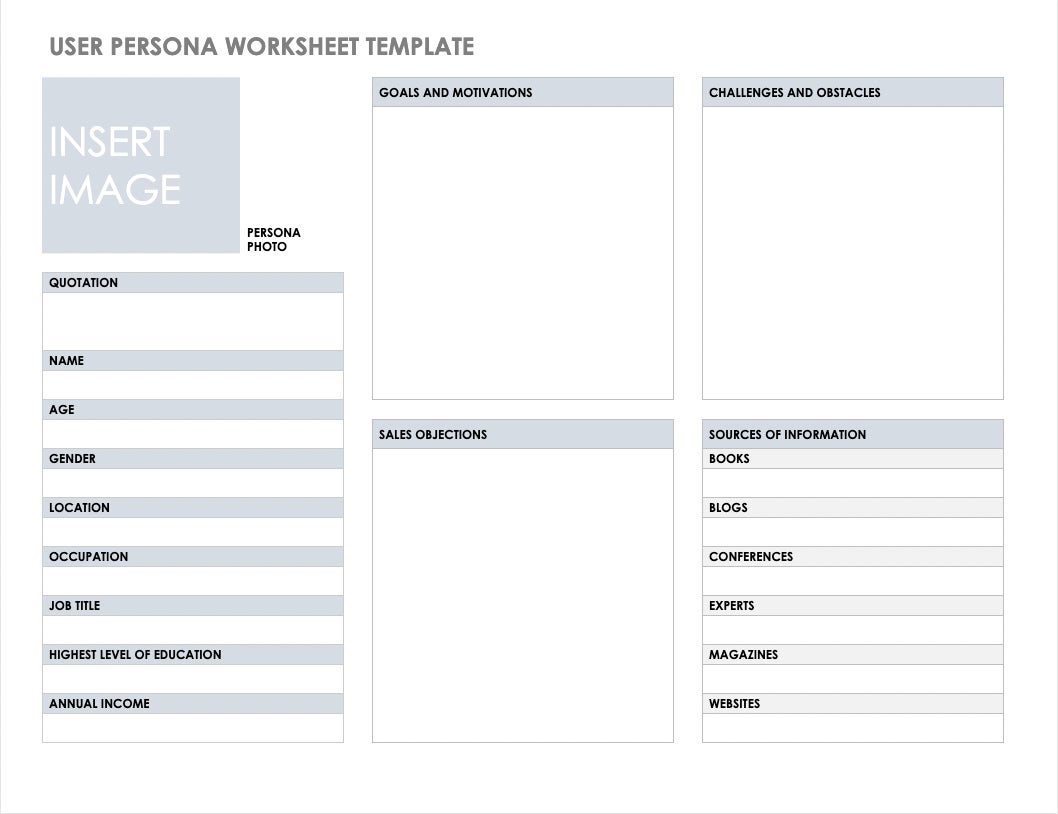
Pro Tip: Baron recommends connecting with the people in the organization who are closest to the customer. The marketing and sales teams will often have the best insights about the customers due to their regular interaction.
3. Map the Competitive Landscape
After you’ve solidified your brand’s core and target audience, articulate how your brand differs from your competitors. Start by identifying your direct competition — the brands that sell similar products and solve the same customer issues — And analyze what they are doing.
Then, define what your target audience isn’t getting from them, how you are different, and why consumers pick your brand over these competitors. Ask, “How does our brand save the customers time, money, or stress?” You should also analyze your indirect competitors or market-adjacent brands to see if there is a gap in the market beyond your initial offering.
Next, analyze the market environment in which your brand does business. Strategyzer, leading corporate innovation strategists and inventors of the business model and value proposition canvases, uses the following four categories to help identify the market environment for disruptive threats and opportunities:
- Market Forces: These are the primary customer issues among your target audience. They could include customer pains and gains, the size of the customer segment over time, and switching costs (the monetary and non-monetary price a customer pays to change brands).
- Key Trends: The primary trends driving market shifts that your brand needs to respond to regularly, such as technological innovations, social trends, and regulations.
- Industry Forces: How the competitors in your primary market have performed historically. These are the dominant performers your brand faces.
- Macro-Economic Forces: The large-scale factors impacting your industry, such as global market conditions, international commodity pricing, and resource access.
With a firm grasp of the market landscape, define your unique value proposition (UVP), specifically how your product is the best at solving its ideal customer’s problem. Then, create your *positioning statement*, the internal document your marketing team uses to craft its messaging to the target audience, in order to determine how your brand will carve out and respond to its market.
As Baron notes, “Your UVP is extremely important. The more differentiated your UVP can be, the more successful your brand will be. Include how your brand is adding value in this competitive environment.”
Pro Tip: Pedersen emphasizes, “The most important step is not only to identify what is wonderful about your business, but also to uncover what makes it truly different. Most people don’t do this — they celebrate what they love about their business, but they don’t discern what sets it apart. Take the time to get crystal clear on what is sharply distinctive about your brand and business. Not just what makes it better than the others, but also what makes it the only one that does something.”
4. Refine Your Brand’s Personality
Your messaging strategy is a multi-pronged approach to help you ensure you accurately and consistently communicate your business with your customers. This step is segmented into two sections: brand essence and brand guidelines.
Brand Essence
Your brand essence (or identity) determines how your brand expresses itself. These are elements that mimic human qualities and capitalize on human nature to connect via personality and character traits. A brand persona template helps define your brand’s personality, tone, voice, and promise to create its essence with the following:
- Personality: This is the personification of your brand through its attitude and personality type. Use a brand personality archetype template to pinpoint which character traits your brand exhibits.
- Tone and Voice: Just like a person, your brand has a specific tone of voice that your customers can quickly identify. Use a brand voice template to select the adjectives that describe how your brand sounds and speaks.
- Brand Promise: Craft your promise to your customers on what they can expect every time they interact with your brand. Your promise can be a short sentence or a series of statements used to build trust with your customers. Your promise sets expectations around what you deliver and what you’ll do if you do not deliver on your promise.
Pro Tip: Pederson emphasizes, “The gist is to be truly person-like. [Be] bold enough to be intriguing and nuanced enough to feel like a real person.”
Brand Guidelines
Create guidelines to codify the brand essence and keep your brand identity consistent with brand content creators. Use a brand style guide template as a quick reference for your team when they employ the brand. Guidelines include the brand essence, plus all standardizations of your unique visual elements, such as your logo, color palette, typography, imagery, compositional style, graphics, visual hierarchy, and iconography. Use a brand visual identity checklist template to make a quick visual reference, such as the below example:
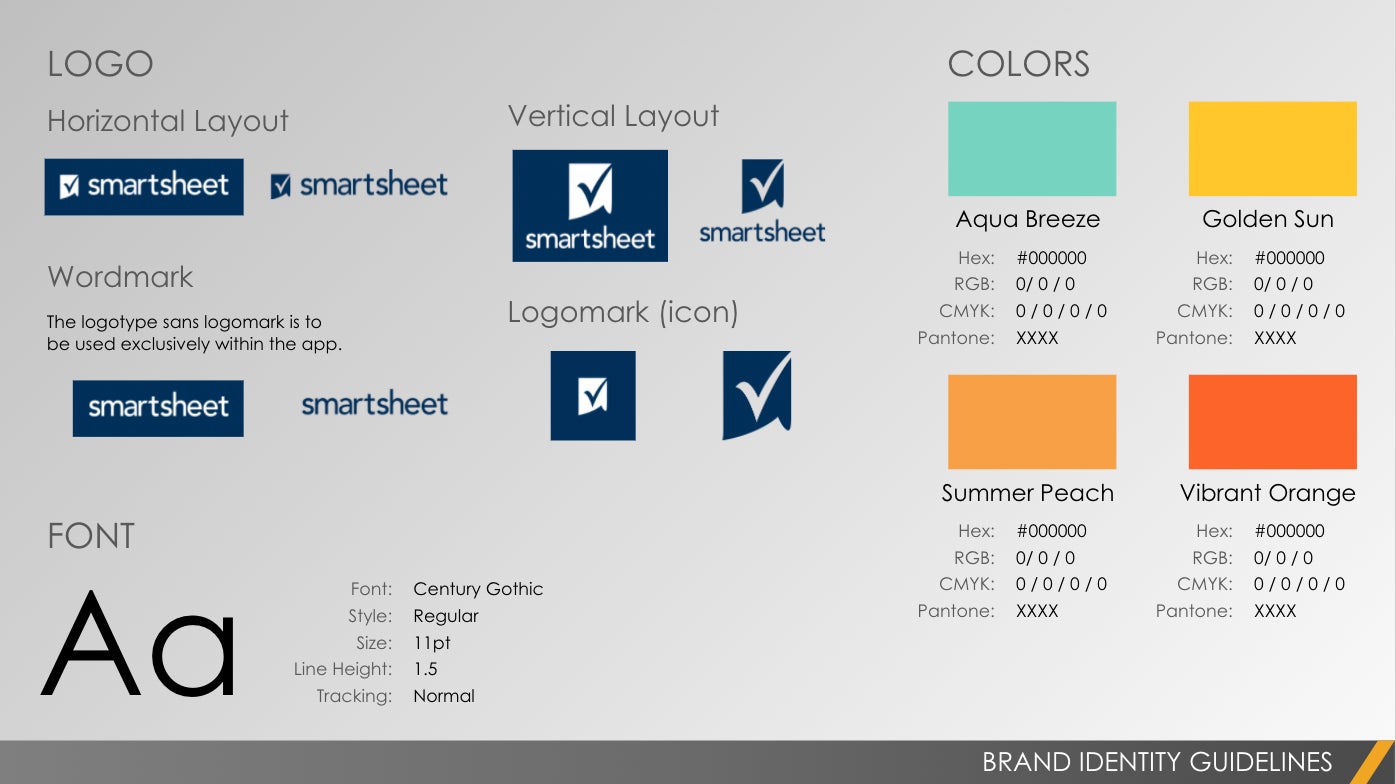
Creating branding guidelines can be a daunting task. View our brand guideline examples to help you get started.
5. Craft Your Brand Story
Using the guidelines you developed in the previous step, determine your brand story so that your customers trust who you are and how you help them.
Then, develop your brand story to shape the audience’s perception. Use key stories, well-placed details, and the brand’s origin story. Use a brand story template as a framework to tell a compelling, authentic story.
Pro Tip: Baron shares that while every document is different, “The story is the baseline for all future storytelling. Keep the baseline consistent: concise, clear, repeatable.”
6. Bring Your Brand to Life
Create a brand messaging strategy that details how you will employ the brand guidelines to communicate what your brand stands for to your audience. In this step, you’ll create dedicated assets to shape your audience’s perception of your brand.
First, define what you want the audience to know at each stage of the buyer’s journey. Then, develop taglines, messaging pillars, and dedicated collateral for each channel.
As you bring your brand to life, make sure it clearly communicates why someone should buy your product or service.
Baron notes the importance of being clear on who you really are and what you stand for: “It’s really important for this particular piece to be so clear and concise that it should be repeatable and understood clearly. As a brand, you want to make sure that when someone hears your name, that it’s not only differentiated. When someone asks ‘Why do you buy x over y?’ they can directly answer, ‘Because they do z.’ Example z responses may be: ‘They support causes I believe in, they are the best quality, or celebrities buy it.’”
Map the Customer Journey: Use your buyer persona to map out their purchasing journey from start to finish. A customer journey map, such as the image below, helps to detail the functional and emotional needs of the buyer for each funnel stage.
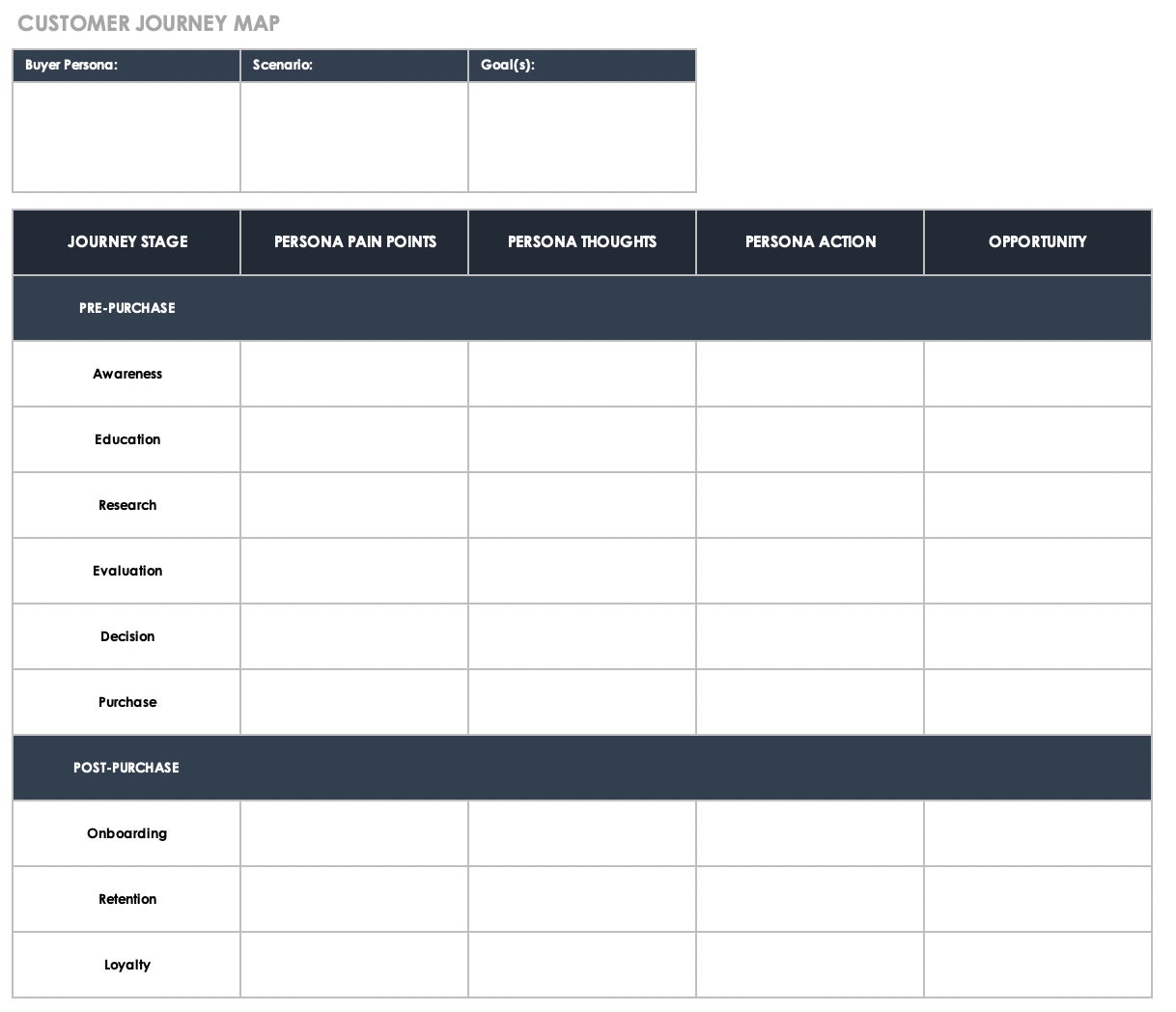
After identifying your ideal customer needs at each stage, assign brand messaging for each phase. As you create messaging, use each instance when a customer interacts with the brands, called moments of truth (MOT), to directly shape customer impressions.
Baron says, “Look at the customer journey. Map everything until the purchase and the follow-up, and [make sure] everyone understands its importance. Any time you hire PR or social team members or any time you want to increase awareness or customer base, you have to understand the customer journey, or you won’t know where your customers ‘live.’”
Use the following three areas to pinpoint which language or call to action (CTA) matches the MOT, while moving your buyer most efficiently to the next journey stage.
- Tagline: A word, sentence, or phrase that is memorable and shareable in the simplest way possible. Example: “Simple luxury. Affordable prices.”
- Messaging Pillars: Three to five one-sentence phrases that support each brand value. These are the elements of how your brand speaks. Your team references these pillars when writing in your brand’s voice.
- Brand Promise: Use the brand promise that you develop in the previous step to build buyer trust. For each phase, ask: “How do we deliver on our brand promise at this stage in the journey?”
Pro Tip: Once you’ve written your tagline and messaging pillars, add them to your brand guidelines as a verbal section of the guide.
Create Brand Artifacts
Once your brand messaging is in place, develop artifacts and content that promote your brand at every MOT. For each channel, touchpoint, and buyer stage, establish a strategy (as well as a reference document) for how your team will communicate in the brand voice.
Make sure your content is always helpful to your audience, follows the brand guidelines, and covers the following areas:
- Company Culture: In your brand strategy document, include onboarding to the brand for new employees, as well as educational strategies to promote a culture based on the brand’s values and mission. Everyone at the company should be able to articulate how they are part of — and add to — the brand.
- Customer Service: Educate your sales and customer service team. Make sure your brand promise delivers on potential pain points, such as product returns. Develop language and behaviors that reflect your brand for your sales team.
- External Agency: If you are hiring an outside agency, use a brand brief or a brand brief template to orient outside contractors.
- Online: Cover all areas of how you’ll share content through your website, online storefront, social media campaigns, advertising campaigns, responses to customer feedback, and more.
- Physical Environment: This refers to the layout and tone of your physical store and office. Consider the experience you want your customer to have the moment they walk by your store. Align this experience with their online experience.
- Print Media: This category includes any printed collateral, such as brochures, business cards, flyers, posters, storefronts, signage, and packaging. What feeling should your customer have when they open your product box?
Pro Tip: Use a brand pyramid as a communication document to bring your brand to life. As your collateral expands, a brand asset management system will help you easily organize and access your catalog.
7. Launch Your Brand
Prepare your brand for launch by creating a brand awareness strategy to implement your messaging and communications strategies and bring them to the public. Calculate your budget to strategize how quickly you will raise your customer’s level of awareness.
The more resources you can allocate toward your brand, the quicker your brand will gain awareness. Your launch strategy also helps you maximize content reach and is especially useful if you have a limited budget.
Use a brand communications plan to execute your brand awareness strategy. Analyze each communication channel to determine the best plan of action for each channel. Organize your brand communications by creating tailored messaging for each channel. Then, add your communications plan to your marketing and PR strategy to develop campaigns. Be sure to include an internal plan to educate all employees on how to talk about the brand.
Pro Tips:
- Keep the brand story involved at every touchpoint.
- If you have a smaller budget, use covert tactics such as posting on forums and group chats.
- With a large budget, closely monitor growth to avoid letting your brand messaging become unwieldy.
- Set success metrics before you launch the brand. Be realistic about your expectations.
- Use benchmarks or multiple phases for a larger launch.
8. Monitor and Maintain Your Brand
After your brand launch, collect performance data, develop insights, and modify your strategy based on these insights. Start with tracking your metrics, then create an improvement plan. Continually manage your brand’s performance to grow your brand equity.
Track the Metrics
Analyze how your content performs in each distribution channel. Does the data compare to how you anticipated? Actively listening on social media provides valuable insights into what your customers say and feel about your brand.
How does the feedback compare to what you want them to say? Ask, “What needs to change to close the gap between what they are saying and what we want them to say?” Use a brand perception survey to collect data on how your consumers describe your brand.
Monitor how your campaigns perform with an analysis tracker. An analysis dashboard template, such as the social media platform tracker below, will help you to visually report key metrics and performance to quickly gain insights.
Optimize Your Impact
Using the collected data, develop your future strategy based on where your consumers responded positively. We reccomend continuously keeping up with industry best practices to ensure you’re driving as much impact as possible.
Conduct an Annual Review
Perform an annual review of the brand strategy, or expedite the review if the market forces and trends shift dramatically. As Baron notes, “We have a performance review of people. We should do a performance review on the brand. Include what you have done well — really go back and look at the document and ask: ‘Does this still hold true?’”
Adjust the Strategy As time goes on, you’ll likely need to adjust your brand strategy. We reccomend revising your brand at key intervals once your data indicates the strategy needs to change. As Baron notes, “What you’re figuring out, in the beginning, is not just the story but also the brand identity — partly what you think it is and partly what your customers think it is. Brands these days are co-created by users or customers and the brand itself. What you stand for is sometimes who is standing with you. Use social media to have a two-way conversation with [your customers]. You’ll really find out what your brand means to them.”
Sample Brand Strategy Document
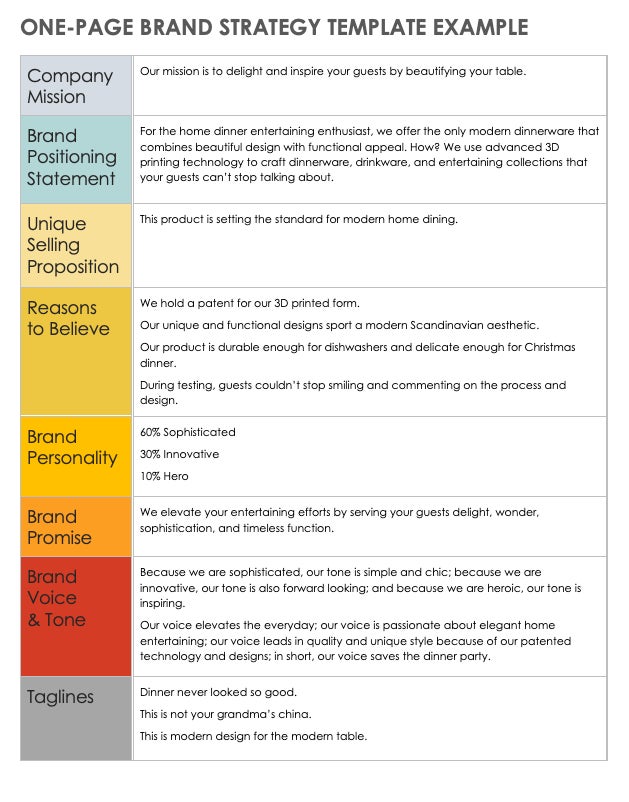
Use this one-page brand strategy example template to develop and create your brand strategy document. Articulate your company mission, brand positioning statement, selling proposition, brand promise, the reasons your customers believe your branding, and your brand voice and tone. This fully customizable template even includes space to document your brand taglines.
Brand Strategy Starter Kit
Looking to get started creating a brand strategy? We’ve got you covered. As a first step, develop your comprehensive brand strategy document with this free tailored brand strategy starter kit. We reccomend walking your team through the brand strategy documentation process from start to finish using our brand strategy brainstorming and research interview worksheets.
Then, document your strategy using either our comprehensive or one-page strategy planning template. Map your customer journey and develop your communication plan. Next, get ready to launch and track your brand’s metrics. Reflect on your brand’s performance and revise with our unique annual document review to pivot your brand for the following year. This template bundle includes the following:
- Brand strategy brainstorming worksheet
- Brand strategy research interview worksheet
- Brand strategy planning template
- One-page brand strategy template
- Customer journey map template
- Brand communications strategy template
- Brand launch strategy template
- Marketing dashboard template
- Brand strategy annual review template
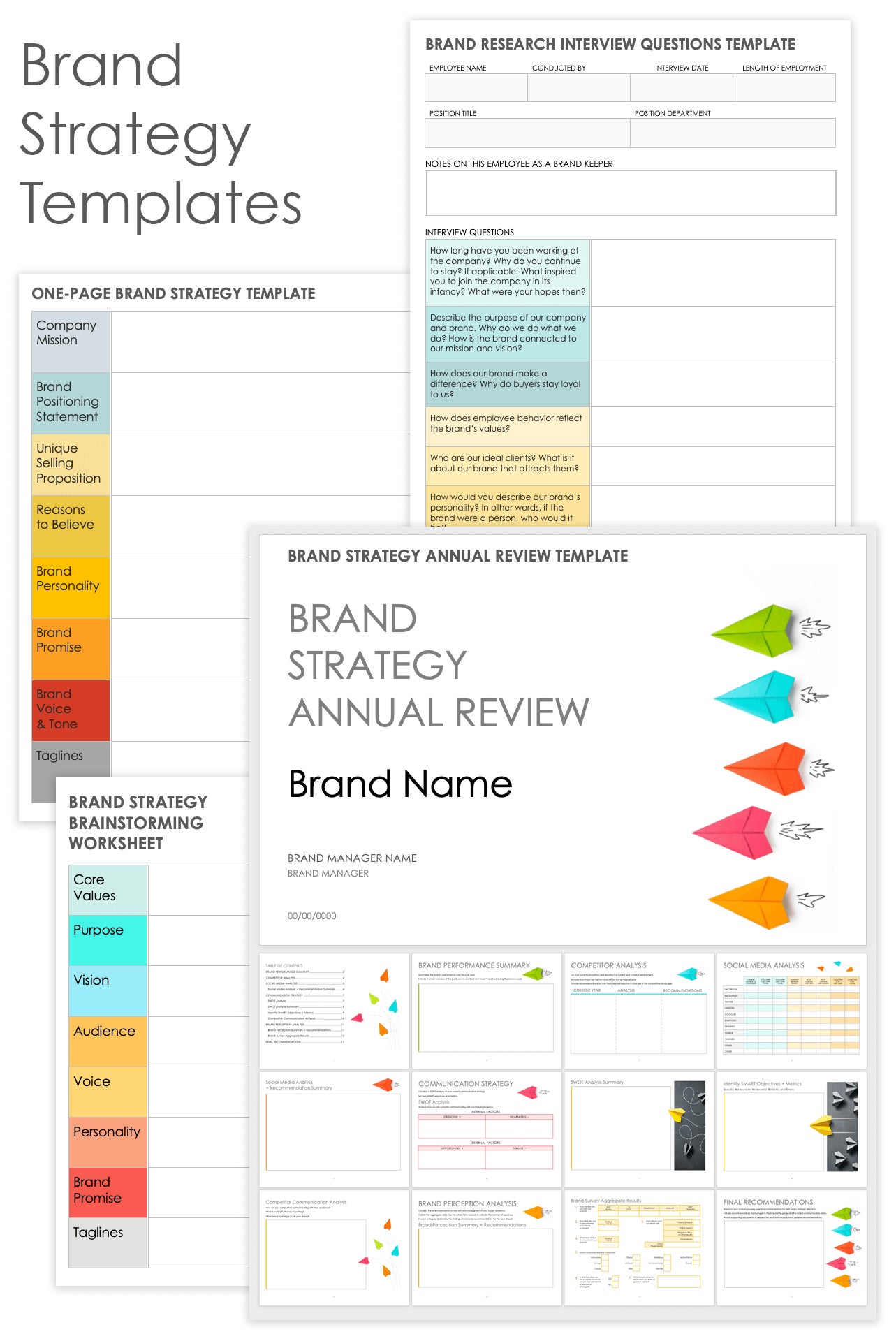
Best Practices for Documenting a Brand Strategy
The best practices for documenting a brand strategy involve continually revisiting it, conducting plenty of research before you begin, and keeping the document simple and specific to help your stakeholders easily use your brand guidelines.
Check out our post, Core Brand Value Examples: Why They Are Key to Differentiating Your Brand
Here’s a roundup of some of the best practices for documenting your brand strategy:
- Start with Something: Don’t get caught up in perfecting the strategy. It’s better to have something to test and revise at an early stage than a perfect strategy that bombs. As Baron encourages, “It’s not a difficult task. It shouldn’t scare anyone.”
- Update Your Brand Strategy Regularly: Schedule your annual review to keep up with the changing market. Remember: A strategy is meant to respond and change to its environment.
Baron says, “It’s really hard to be successful if you’re stagnant. Your strategy has to evolve because of things like new competitors, a changing customer base, or social movements that change people. The biggest mistake is thinking, ‘It’s 2022, my brand will be the same in 2025.’ The world around you changes and you have to constantly adapt. Always ask yourself if the strategy is working and work to redefine who you are. That doesn’t mean what you stand for or your story changes — that’s evergreen. But you can adapt by offering different products, services, or graphics.”
- Research Before You Start the Document: Tap into people who have deep organizational knowledge. Get input from stakeholders to ensure that the document is highly useful.
“Ultimately, you’re putting the document together for other people,” says Baron. “Work with anyone externally who will encounter the document to get their input.”
- Keep It Simple: Maintain the document’s tight focus on the target market by keeping the UVP at the forefront. Organize your document to be easily readable for anyone referencing it.
- Be Specific: Generic documents create lackluster brands. Use specific details and highlight what makes your brand unique.
Baron encourages people to “not be too generic — be as specific as possible. Conduct extensive research to make sure your document is comprehensive. Don’t use buzzwords.”
- Own the Document: If you are the assigned brand manager, take full ownership of the document to maintain its integrity.
“The leader needs to own the brand strategy,” says Pedersen. “As soon as a leader delegates brand strategy to someone else (be it marketing, an agency, or anyone else), it stops being a brand strategy.”
Ready to get started? Check out our post on how to differentiate in a crowded market.

